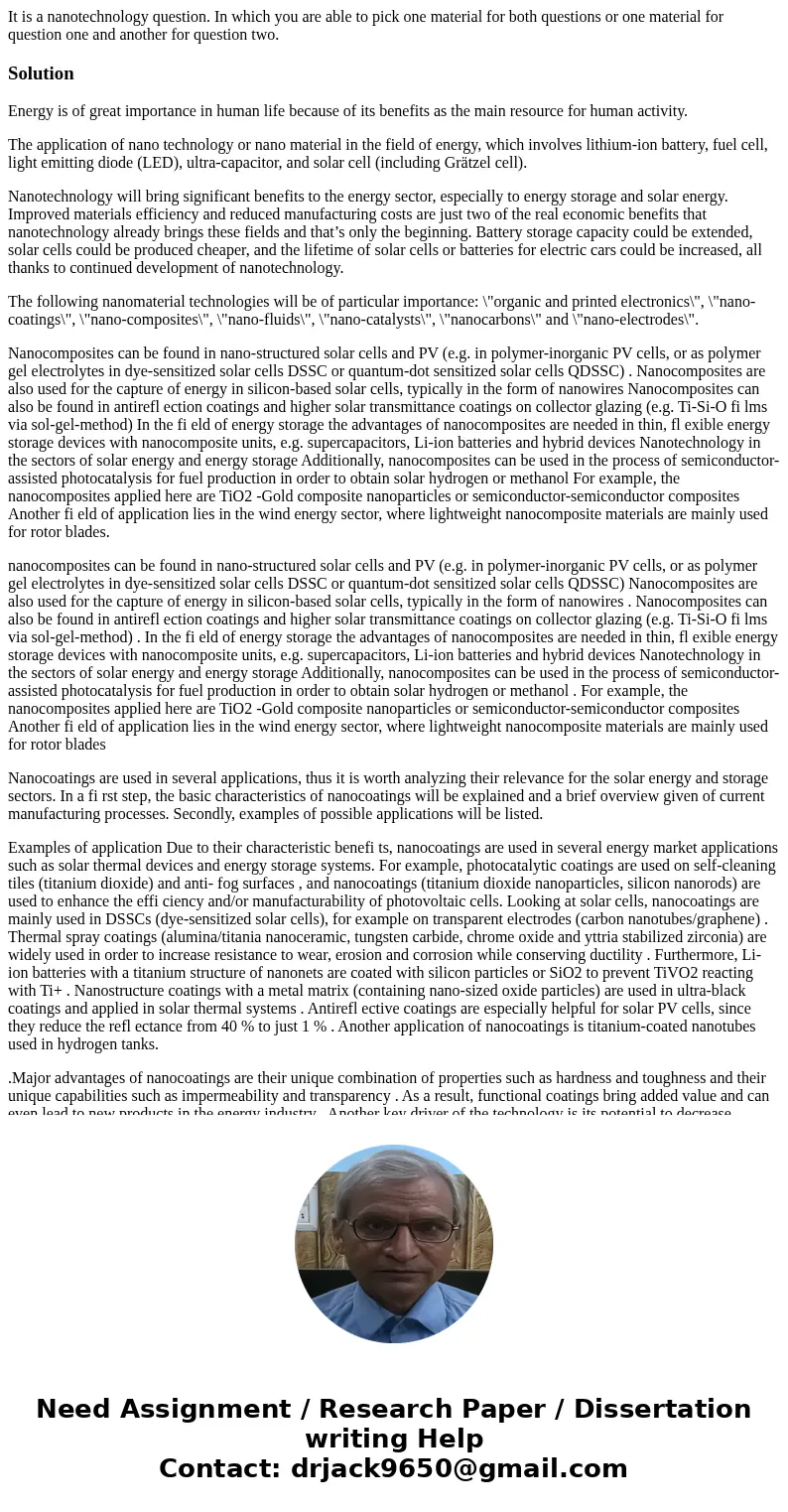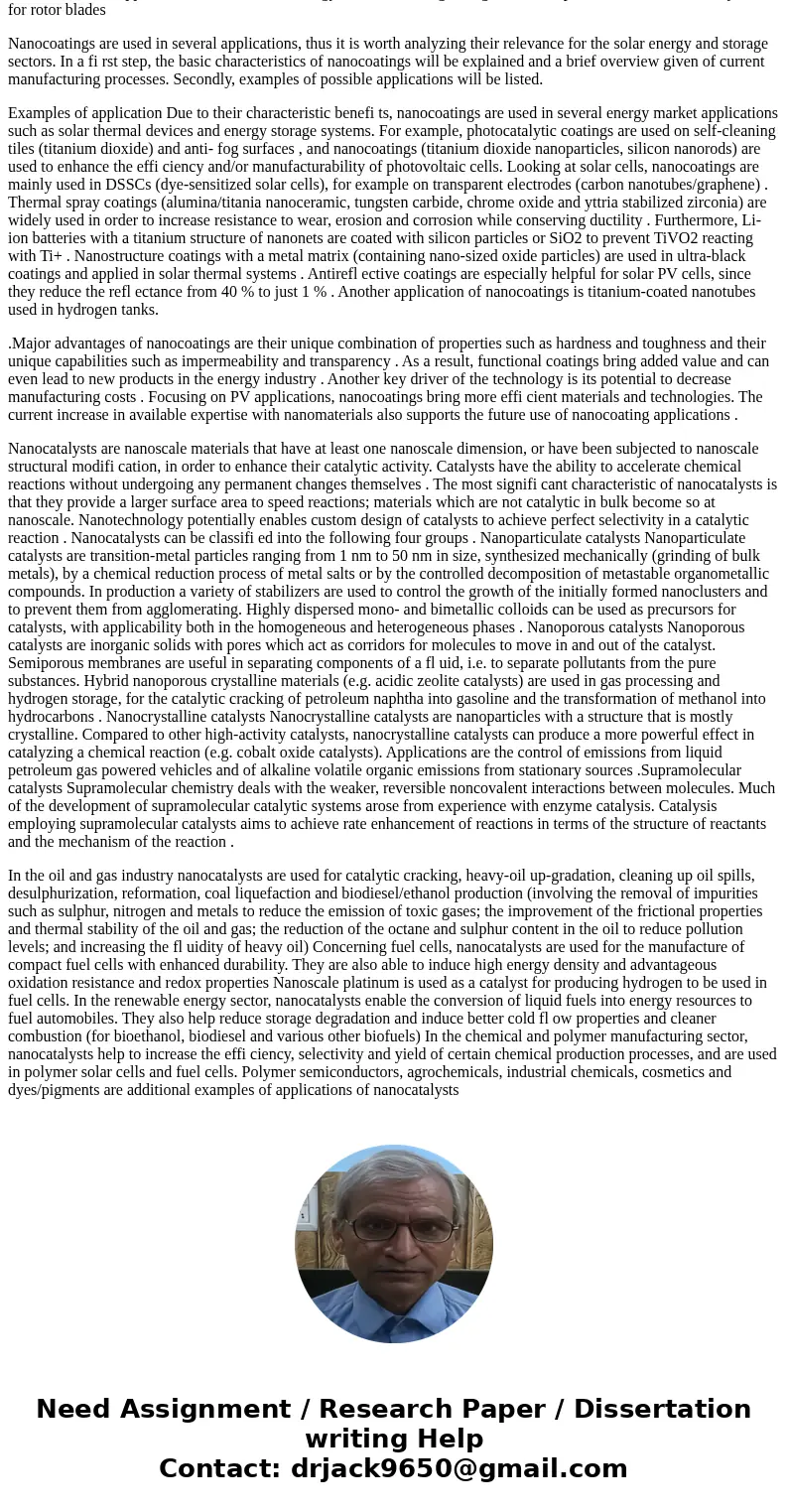It is a nanotechnology question In which you are able to pic
It is a nanotechnology question. In which you are able to pick one material for both questions or one material for question one and another for question two.
Solution
Energy is of great importance in human life because of its benefits as the main resource for human activity.
The application of nano technology or nano material in the field of energy, which involves lithium-ion battery, fuel cell, light emitting diode (LED), ultra-capacitor, and solar cell (including Grätzel cell).
Nanotechnology will bring significant benefits to the energy sector, especially to energy storage and solar energy. Improved materials efficiency and reduced manufacturing costs are just two of the real economic benefits that nanotechnology already brings these fields and that’s only the beginning. Battery storage capacity could be extended, solar cells could be produced cheaper, and the lifetime of solar cells or batteries for electric cars could be increased, all thanks to continued development of nanotechnology.
The following nanomaterial technologies will be of particular importance: \"organic and printed electronics\", \"nano-coatings\", \"nano-composites\", \"nano-fluids\", \"nano-catalysts\", \"nanocarbons\" and \"nano-electrodes\".
Nanocomposites can be found in nano-structured solar cells and PV (e.g. in polymer-inorganic PV cells, or as polymer gel electrolytes in dye-sensitized solar cells DSSC or quantum-dot sensitized solar cells QDSSC) . Nanocomposites are also used for the capture of energy in silicon-based solar cells, typically in the form of nanowires Nanocomposites can also be found in antirefl ection coatings and higher solar transmittance coatings on collector glazing (e.g. Ti-Si-O fi lms via sol-gel-method) In the fi eld of energy storage the advantages of nanocomposites are needed in thin, fl exible energy storage devices with nanocomposite units, e.g. supercapacitors, Li-ion batteries and hybrid devices Nanotechnology in the sectors of solar energy and energy storage Additionally, nanocomposites can be used in the process of semiconductor-assisted photocatalysis for fuel production in order to obtain solar hydrogen or methanol For example, the nanocomposites applied here are TiO2 -Gold composite nanoparticles or semiconductor-semiconductor composites Another fi eld of application lies in the wind energy sector, where lightweight nanocomposite materials are mainly used for rotor blades.
nanocomposites can be found in nano-structured solar cells and PV (e.g. in polymer-inorganic PV cells, or as polymer gel electrolytes in dye-sensitized solar cells DSSC or quantum-dot sensitized solar cells QDSSC) Nanocomposites are also used for the capture of energy in silicon-based solar cells, typically in the form of nanowires . Nanocomposites can also be found in antirefl ection coatings and higher solar transmittance coatings on collector glazing (e.g. Ti-Si-O fi lms via sol-gel-method) . In the fi eld of energy storage the advantages of nanocomposites are needed in thin, fl exible energy storage devices with nanocomposite units, e.g. supercapacitors, Li-ion batteries and hybrid devices Nanotechnology in the sectors of solar energy and energy storage Additionally, nanocomposites can be used in the process of semiconductor-assisted photocatalysis for fuel production in order to obtain solar hydrogen or methanol . For example, the nanocomposites applied here are TiO2 -Gold composite nanoparticles or semiconductor-semiconductor composites Another fi eld of application lies in the wind energy sector, where lightweight nanocomposite materials are mainly used for rotor blades
Nanocoatings are used in several applications, thus it is worth analyzing their relevance for the solar energy and storage sectors. In a fi rst step, the basic characteristics of nanocoatings will be explained and a brief overview given of current manufacturing processes. Secondly, examples of possible applications will be listed.
Examples of application Due to their characteristic benefi ts, nanocoatings are used in several energy market applications such as solar thermal devices and energy storage systems. For example, photocatalytic coatings are used on self-cleaning tiles (titanium dioxide) and anti- fog surfaces , and nanocoatings (titanium dioxide nanoparticles, silicon nanorods) are used to enhance the effi ciency and/or manufacturability of photovoltaic cells. Looking at solar cells, nanocoatings are mainly used in DSSCs (dye-sensitized solar cells), for example on transparent electrodes (carbon nanotubes/graphene) . Thermal spray coatings (alumina/titania nanoceramic, tungsten carbide, chrome oxide and yttria stabilized zirconia) are widely used in order to increase resistance to wear, erosion and corrosion while conserving ductility . Furthermore, Li-ion batteries with a titanium structure of nanonets are coated with silicon particles or SiO2 to prevent TiVO2 reacting with Ti+ . Nanostructure coatings with a metal matrix (containing nano-sized oxide particles) are used in ultra-black coatings and applied in solar thermal systems . Antirefl ective coatings are especially helpful for solar PV cells, since they reduce the refl ectance from 40 % to just 1 % . Another application of nanocoatings is titanium-coated nanotubes used in hydrogen tanks.
.Major advantages of nanocoatings are their unique combination of properties such as hardness and toughness and their unique capabilities such as impermeability and transparency . As a result, functional coatings bring added value and can even lead to new products in the energy industry . Another key driver of the technology is its potential to decrease manufacturing costs . Focusing on PV applications, nanocoatings bring more effi cient materials and technologies. The current increase in available expertise with nanomaterials also supports the future use of nanocoating applications .
Nanocatalysts are nanoscale materials that have at least one nanoscale dimension, or have been subjected to nanoscale structural modifi cation, in order to enhance their catalytic activity. Catalysts have the ability to accelerate chemical reactions without undergoing any permanent changes themselves . The most signifi cant characteristic of nanocatalysts is that they provide a larger surface area to speed reactions; materials which are not catalytic in bulk become so at nanoscale. Nanotechnology potentially enables custom design of catalysts to achieve perfect selectivity in a catalytic reaction . Nanocatalysts can be classifi ed into the following four groups . Nanoparticulate catalysts Nanoparticulate catalysts are transition-metal particles ranging from 1 nm to 50 nm in size, synthesized mechanically (grinding of bulk metals), by a chemical reduction process of metal salts or by the controlled decomposition of metastable organometallic compounds. In production a variety of stabilizers are used to control the growth of the initially formed nanoclusters and to prevent them from agglomerating. Highly dispersed mono- and bimetallic colloids can be used as precursors for catalysts, with applicability both in the homogeneous and heterogeneous phases . Nanoporous catalysts Nanoporous catalysts are inorganic solids with pores which act as corridors for molecules to move in and out of the catalyst. Semiporous membranes are useful in separating components of a fl uid, i.e. to separate pollutants from the pure substances. Hybrid nanoporous crystalline materials (e.g. acidic zeolite catalysts) are used in gas processing and hydrogen storage, for the catalytic cracking of petroleum naphtha into gasoline and the transformation of methanol into hydrocarbons . Nanocrystalline catalysts Nanocrystalline catalysts are nanoparticles with a structure that is mostly crystalline. Compared to other high-activity catalysts, nanocrystalline catalysts can produce a more powerful effect in catalyzing a chemical reaction (e.g. cobalt oxide catalysts). Applications are the control of emissions from liquid petroleum gas powered vehicles and of alkaline volatile organic emissions from stationary sources .Supramolecular catalysts Supramolecular chemistry deals with the weaker, reversible noncovalent interactions between molecules. Much of the development of supramolecular catalytic systems arose from experience with enzyme catalysis. Catalysis employing supramolecular catalysts aims to achieve rate enhancement of reactions in terms of the structure of reactants and the mechanism of the reaction .
In the oil and gas industry nanocatalysts are used for catalytic cracking, heavy-oil up-gradation, cleaning up oil spills, desulphurization, reformation, coal liquefaction and biodiesel/ethanol production (involving the removal of impurities such as sulphur, nitrogen and metals to reduce the emission of toxic gases; the improvement of the frictional properties and thermal stability of the oil and gas; the reduction of the octane and sulphur content in the oil to reduce pollution levels; and increasing the fl uidity of heavy oil) Concerning fuel cells, nanocatalysts are used for the manufacture of compact fuel cells with enhanced durability. They are also able to induce high energy density and advantageous oxidation resistance and redox properties Nanoscale platinum is used as a catalyst for producing hydrogen to be used in fuel cells. In the renewable energy sector, nanocatalysts enable the conversion of liquid fuels into energy resources to fuel automobiles. They also help reduce storage degradation and induce better cold fl ow properties and cleaner combustion (for bioethanol, biodiesel and various other biofuels) In the chemical and polymer manufacturing sector, nanocatalysts help to increase the effi ciency, selectivity and yield of certain chemical production processes, and are used in polymer solar cells and fuel cells. Polymer semiconductors, agrochemicals, industrial chemicals, cosmetics and dyes/pigments are additional examples of applications of nanocatalysts


 Homework Sourse
Homework Sourse